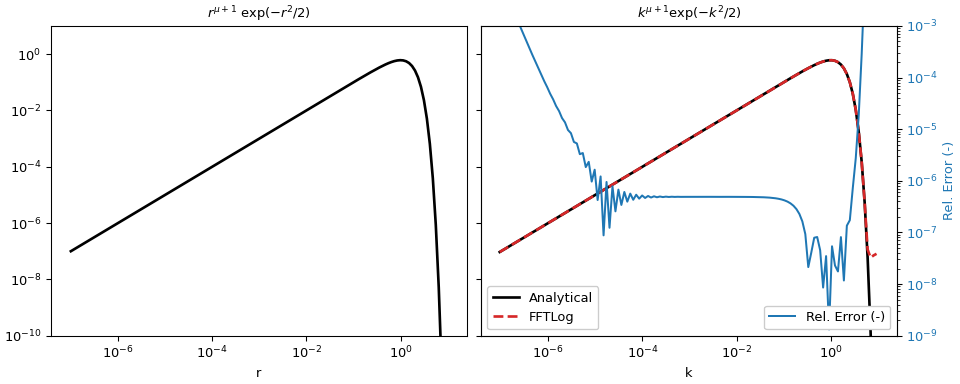scipy.fft.fht#
- scipy.fft.fht(a, dln, mu, offset=0.0, bias=0.0)[source]#
Compute the fast Hankel transform.
Computes the discrete Hankel transform of a logarithmically spaced periodic sequence using the FFTLog algorithm [1], [2].
- Parameters:
- aarray_like (…, n)
Real periodic input array, uniformly logarithmically spaced. For multidimensional input, the transform is performed over the last axis.
- dlnfloat
Uniform logarithmic spacing of the input array.
- mufloat
Order of the Hankel transform, any positive or negative real number.
- offsetfloat, optional
Offset of the uniform logarithmic spacing of the output array.
- biasfloat, optional
Exponent of power law bias, any positive or negative real number.
- Returns:
- Aarray_like (…, n)
The transformed output array, which is real, periodic, uniformly logarithmically spaced, and of the same shape as the input array.
Notes
This function computes a discrete version of the Hankel transform
\[A(k) = \int_{0}^{\infty} \! a(r) \, J_\mu(kr) \, k \, dr \;,\]where \(J_\mu\) is the Bessel function of order \(\mu\). The index \(\mu\) may be any real number, positive or negative.
The input array a is a periodic sequence of length \(n\), uniformly logarithmically spaced with spacing dln,
\[a_j = a(r_j) \;, \quad r_j = r_c \exp[(j-j_c) \, \mathtt{dln}]\]centred about the point \(r_c\). Note that the central index \(j_c = (n-1)/2\) is half-integral if \(n\) is even, so that \(r_c\) falls between two input elements. Similarly, the output array A is a periodic sequence of length \(n\), also uniformly logarithmically spaced with spacing dln
\[A_j = A(k_j) \;, \quad k_j = k_c \exp[(j-j_c) \, \mathtt{dln}]\]centred about the point \(k_c\).
The centre points \(r_c\) and \(k_c\) of the periodic intervals may be chosen arbitrarily, but it would be usual to choose the product \(k_c r_c = k_j r_{n-1-j} = k_{n-1-j} r_j\) to be unity. This can be changed using the offset parameter, which controls the logarithmic offset \(\log(k_c) = \mathtt{offset} - \log(r_c)\) of the output array. Choosing an optimal value for offset may reduce ringing of the discrete Hankel transform.
If the bias parameter is nonzero, this function computes a discrete version of the biased Hankel transform
\[A(k) = \int_{0}^{\infty} \! a_q(r) \, (kr)^q \, J_\mu(kr) \, k \, dr\]where \(q\) is the value of bias, and a power law bias \(a_q(r) = a(r) \, (kr)^{-q}\) is applied to the input sequence. Biasing the transform can help approximate the continuous transform of \(a(r)\) if there is a value \(q\) such that \(a_q(r)\) is close to a periodic sequence, in which case the resulting \(A(k)\) will be close to the continuous transform.
References
[1]Talman J. D., 1978, J. Comp. Phys., 29, 35
Examples
This example is the adapted version of
fftlogtest.fwhich is provided in [2]. It evaluates the integral\[\int^\infty_0 r^{\mu+1} \exp(-r^2/2) J_\mu(k, r) k dr = k^{\mu+1} \exp(-k^2/2) .\]>>> import numpy as np >>> from scipy import fft >>> import matplotlib.pyplot as plt
Parameters for the transform.
>>> mu = 0.0 # Order mu of Bessel function >>> r = np.logspace(-7, 1, 128) # Input evaluation points >>> dln = np.log(r[1]/r[0]) # Step size >>> offset = fft.fhtoffset(dln, initial=-6*np.log(10), mu=mu) >>> k = np.exp(offset)/r[::-1] # Output evaluation points
Define the analytical function.
>>> def f(x, mu): ... """Analytical function: x^(mu+1) exp(-x^2/2).""" ... return x**(mu + 1)*np.exp(-x**2/2)
Evaluate the function at
rand compute the corresponding values atkusing FFTLog.>>> a_r = f(r, mu) >>> fht = fft.fht(a_r, dln, mu=mu, offset=offset)
For this example we can actually compute the analytical response (which in this case is the same as the input function) for comparison and compute the relative error.
>>> a_k = f(k, mu) >>> rel_err = abs((fht-a_k)/a_k)
Plot the result.
>>> figargs = {'sharex': True, 'sharey': True, 'constrained_layout': True} >>> fig, (ax1, ax2) = plt.subplots(1, 2, figsize=(10, 4), **figargs) >>> ax1.set_title(r'$r^{\mu+1}\ \exp(-r^2/2)$') >>> ax1.loglog(r, a_r, 'k', lw=2) >>> ax1.set_xlabel('r') >>> ax2.set_title(r'$k^{\mu+1} \exp(-k^2/2)$') >>> ax2.loglog(k, a_k, 'k', lw=2, label='Analytical') >>> ax2.loglog(k, fht, 'C3--', lw=2, label='FFTLog') >>> ax2.set_xlabel('k') >>> ax2.legend(loc=3, framealpha=1) >>> ax2.set_ylim([1e-10, 1e1]) >>> ax2b = ax2.twinx() >>> ax2b.loglog(k, rel_err, 'C0', label='Rel. Error (-)') >>> ax2b.set_ylabel('Rel. Error (-)', color='C0') >>> ax2b.tick_params(axis='y', labelcolor='C0') >>> ax2b.legend(loc=4, framealpha=1) >>> ax2b.set_ylim([1e-9, 1e-3]) >>> plt.show()
